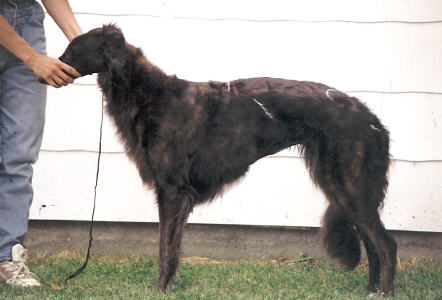
Myths of the Borzoi Topline
There has been quite a bit of talk in recent years about the topline of the borzoi. Many people have strongly held opinions about where the highest point of the topline should be. The traditional view is that the highest point is just above the last rib. More recently some have expressed the opinion that both the highest point and the beginning of the rise should be further back. Many of these opinions demonstrate a lack of knowledge of canine anatomy; certainly they demonstrate that people are not looking very closely at their own dogs!
ALL borzoi have the beginning of the rise and the highest point of the rise at the same anatomical location! The rise begins with the 12th thoracic vertebra and reaches its highest point at the 2nd to 3rd lumbar vertebra just above the last rib. Now the highest point of the topline can vary with the horizon depending on the rest of the dog's conformation, but it never varies relative to the spine itself.
The following three photographs are of an out of coat borzoi bitch. What little coat she has is slicked down with hair spray, so the outline seen is not distorted by grooming. "White-out" has been used to mark (front to back) 1] the level of thoracic vertebra 11, 2] the 13th rib, 3] the iliac crest (front -most edge of the pelvis).

Photo A is of the bitch standing on level ground with forelegs and hocks perpendicular. Her withers and iliac crest are at the same balanced level. Notice that the highest point of the topline is right over the last rib.
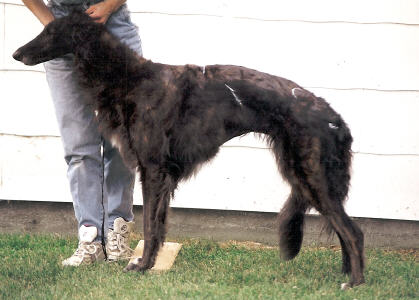
Photo B is the same bitch in the same position, only her front feet are on a 3/4 inch board. Now that her front is higher than her rear, the high point of her topline appears to have moved forward!! Look again- turn the photo slightly- the high point hasn't changed relative to the spine itself -it has only changed relative to the background. This would be the appearance of a borzoi with a normal spine who is higher in the front than the rear.
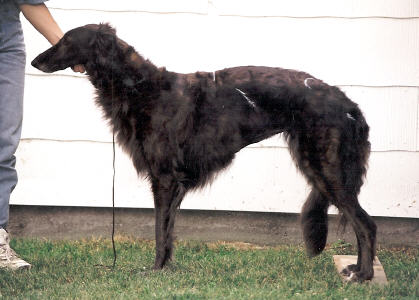
Photo C is the same bitch in the same position, only her rear feet are on a 3/4 inch board. Now her rear is higher than her front and the high point appears to have moved backwards!! Again the dog and the spine haven't changed - only the appearance relative to the background. This would be the appearance of a borzoi with a normal spine that is higher in the rear than the front.
But please don't take my word for it!! Try this at home with your own hounds. (Although I would avoid using Whiteout it doesn't wash out as easily as I'd hoped.)
The following section is a mini course in canine anatomy of the thoracic and lumbar spine. The sketch provided is of a skeleton of a dog - just your basic dog, not a sighthound specifically.
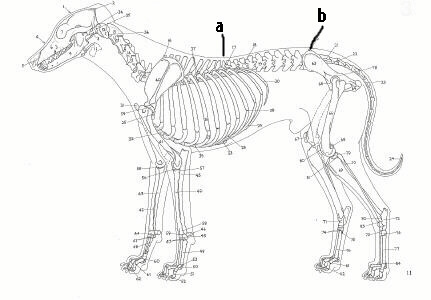 |
a - anticlinal vertebra
b-iliac crest |
The spine is made up of small bone segments called vertebrae. Each vertebra is attached to other bones through joints. The joints allow the bones to move in specific fashions as dictated by the type of joint and the muscles attached .The vertebrae are divided into 5 groups:
-7 cervical (neck) vertebrae
-13 thoracic (chest) vertebrae - each thoracic vertebra is connected to a rib on each side.
-7 lumbar vertebrae
-3 (fused) sacral vertebrae (joins the spine to the pelvis)
-20 to 24 caudal (tail) vertebrae
Notice on the skeleton that the thoracic and lumbar vertebrae have long processes sticking up. The tops of these processes are the bones you feel under the skin along the back of your dog. The main body of these vertebra are hidden under layers of muscle. It is these spinous processes and their relative height and position to each other that controls the "topline".
Take particular note of the 11th thoracic vertebra - notice it has a distinctly short spinous process that points straight up. This vertebra has a special name; it is called the anticlinal vertebra. Find this location on any dog who isn't horribly obese, by running one finger right along the top of the back from the withers toward the tail, after about 6 - 10 inches your finger will fall into a small depression or divot. Your finger is now at the anticlinal vertebra.
Now keep going back toward the tail. The next bone that you feel is the process of T12 . It is slightly higher up than T11 (it has to be because the spinous process is longer) This is the beginning of the "graceful curve ". This vertebra (T12) is also the rearmost place where the ribs are attached to the other bones of the chest. The next spinous process you feel is T13. The ribs of T13 have the particular quality of being free of any other joint attachment. While you are here feel the last rib; notice how far it goes back toward the tail instead of toward the ground.
In the borzoi and other breeds with a rise at the loins, the muscles and connective tissue pull the less "fixed" vertebrae of T13 and the lumbar vertebrae into an arch that rises most sharply from T13 to lumbar 2 then continues more gradually to the place where the spine is "fixed" to the pelvis at the sacrum. On your borzoi at home, keep your finger traveling back one vertebra at a time, and you will be able to feel this. After the fourth lumbar vertebra the spinous processes will become more indistinct -blurred by surrounding muscle (or fat !!). About the level of the iliac crest you will loose the ability to count individual spinous processes - unless you have a very thin borzoi.
Remember this is not my opinion, or how I think a borzoi "should" look - this is just how their spine is built. The lowest point is at T11 and the rise starts there, reaches its highest point at L2 then evens out toward the pelvis.
Now let's look at what the standard does say about the topline.
BACK- Rising a little at the loins in a graceful curve.
LOINS- Extremely muscular, but rather tucked up, owing to the great depth of chest and comparative shortness of back and ribs.
The relative location of the beginning of the rise is addressed by the phrase 'comparative shortness of back and ribs'. Look again at the skeleton diagram. Notice again that the thoracic vertebrae up to T12 are relatively fixed in place by their attachments to the ribs and sternum and T13 through the lumbar vertebra have much greater freedom of motion. So the standard claims that the 'back' (used here to describe the rather flat area of the topline between the withers and T12) and the attached 'ribs' should be short relative to the topline as a whole!
If we think of the borzoi as a galloping hound - and we should! This description makes perfect sense. The more flexible portion of the spine is noticeably longer than the relatively fixed back and ribs. Flexibility is determined by other factors also, of course, but even a very flexible loin cannot undergo the full range of motion if it is too short. In fact, the ratio of loin length to back length is responsible for the majority of a borzoi's total speed. In the fastest borzoi, the length from the anticlinal vertebra to the iliac crest is twice the length from the first thoracic vetebra to the anticlinal vertebra.
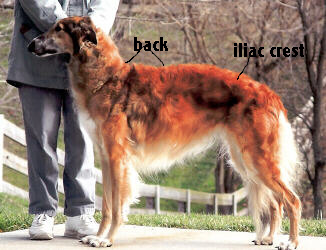
Photo D is of a standing borzoi with little coat. You can easily see the flat back from withers to T12 then noticeably longer from that point through the rise to the pelvis.
Photos E and F demonstrate this same dog at maximum flexion and extension.
Try, then, not to trust those myths fixating on the "silhouette of the topline" created by the hound's posture. But instead concentrate on the topline components as referred to in the standard … muscular … rather tucked up … comparative shortness of back and ribs … a graceful curve.